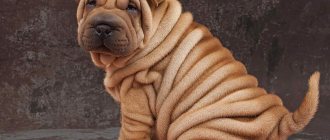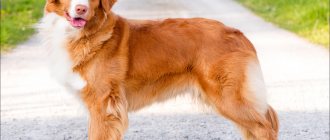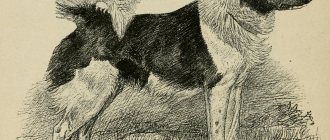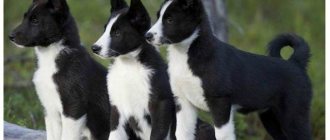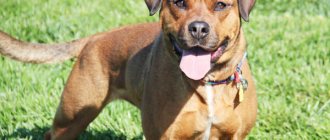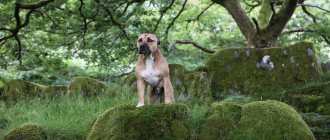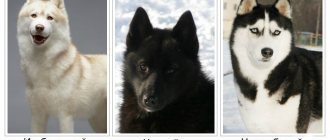A wolf dog is the dream of many animal lovers. But how adapted are such hybrids to living next to humans? The first crossbreeding of a dog and a wolf was recorded in Great Britain in 1766. A Spitz was bred with a wild animal. The resulting offspring had the appearance of a wolf, but had a softer character.
Not all dog breeds are suitable for crossbreeding. Today, several officially recognized dog-wolf hybrids have been bred; it is more correct to call them wolf-dogs or wolf-dogs. In addition, there are dogs that resemble wolves only in appearance.
Czechoslovakian wolfdog
Breeding of this breed began in 1955 in a nursery in the city of Libejovica. The ancestor of the breed was the she-wolf Brita, the father was a male German shepherd. A cross between a wolf and a dog today has 30% wolf blood.
Wolfdogs were bred with the goal of producing an animal with the endurance, strength and flair of a wolf, combined with the working qualities and controllability of a dog. The first experiments turned out to be successful - the resulting hybrid of a wolf and a dog successfully served in the border troops. In the 1970s, representatives of the breed were exported to the UK.
The wolfdog is active, intelligent, and amenable to training. Maximum attention should be paid to the upbringing and socialization of a young animal. Possible aggression towards small animals.
Appearance and features
Photo: What a wolfdog looks like
Despite the well-founded stereotype of a combination of courage, aggressiveness, endurance and willfulness, wolf-dogs (like any other animals) are very different from each other in character. Moreover, the decisive role in this case is determined by the percentage of wolf blood - the descendants of F2-F3 will be more similar in their disposition to good-natured malamutes, huskies and huskies. On the other hand, in one litter there are often both socially adapted, sociable puppies and shy individuals who are unsociable from birth.
All these points are determined by the genetic heritage of the parents and, of course, upbringing. It is for this reason that getting a wolf-dog is recommended only for those people who already have experience in training large and aggressive breeds of dogs. With the proper approach to education, you can turn a formidable wolf-dog into a reliable friend and devoted protector.
Moreover, wolf-dogs, raised from childhood together with other dogs, then get along well with them. But in most cases, they establish their dominance in the “pack”. If a wolf-dog does not show any manifestations of neophobia - fear of everything new, then it will be very easy with him in the process of education and socialization. Such wolf-dogs are unusually curious, active and affectionate.
Now you know what a hybrid of a wolf and a dog looks like. Let's see where wolf-dogs live.
Wolfdog of Saarloos
This cross between a wolf and a dog was bred in Holland in 1925 by dog handler Lendert Sarloos. The ancestors of the breed were the she-wolf Flera and the male German shepherd. The best puppies were selected for further breeding. The breed was recognized and registered in 1981.
The wolf dog is quite large - up to 76 cm at the withers and up to 42 kg in weight. They are independent, live according to the law of the pack, but are attached to the owner and recognize him as the leader. Saarloos wolfdogs are wary and prefer to avoid danger. But this natural timidity does not become the cause of aggression. An interesting feature is that hybrids do not bark, but use sounds characteristic of wolves - whining, howling, growling.
A dog crossed with a wolf is used as a rescuer and guide dog. They have a developed hunting instinct, which allows them to be used as hunting dogs.
This hybrid of a wolf and a dog is quite rare, and the price for puppies is high - about $2000.
Recognized breeds similar to wolves
According to the theory of the recognized zoologist from Austria K. Lorenz, dogs descended from jackals. But it is difficult to connect individuals externally and by behavior. Many dog breeds are similar to wolves.
A dog that looks like a wolf
Italian Wolfdog Lupo Italiano
The blood of a German shepherd and an Apennine wolf flows in the veins of the “Italian”. A working breed, people use it in rescue operations. The animal is large, so it is difficult to keep in an apartment.
Note! These are very loyal dogs that prefer a single owner.
Siberian Husky
The height of males at the withers is 53-60 cm, females – 50-56 cm. Weight – up to 28 kg. Presumably bred by the Chukchi, who needed hardy sled dogs to move with cargo over long distances.
Huskies are a beautiful breed of hard workers. They can be trained from suckling age. Later, it will be difficult to tame the animal.
Description of the Northern Inuit breed
The wolf appearance has nothing to do with the breed. The Inuit ancestry is pure. A dog with a wedge-shaped skull weighs up to 50 kg. Height at the withers is up to 76 cm.
Other data:
- black color;
- jaws with a complete dental formula;
- eyes with a yellowish iris, elongated, outer corners raised;
- ears are erect, large;
- the back and neck are muscular;
- muscles are developed, the body is flexible.
Inuit fur has a thick undercoat, which protects the animal well from frost and moisture.
Czechoslovakian Wolfdog
Czechoslovakian Wolfdog
The Carpathian wolf and the German shepherd gave working offspring, suitable for guarding, hunting, and detective work. An excellent guard and trusting companion with an expressive appearance.
Kunming wolf dog
Bred by Chinese military dog handlers to search for mines and rescue service. Well amenable to training. Trained dogs do not know fatigue. The appearance is colorful, there is no exact information about the gene pool.
Canadian Eskimo dog
The oldest breed. The cost for a purebred puppy is incredibly high. It is believed that it came to Canada and Greenland from the Russian north.
The working animal easily endures the harsh northern conditions. The thick coat is lubricated with fat, so the sled dog survives minus 50 degrees without complications. Close in parameters to husky.
Amerind Malamute or Kugsha
A powerful animal with long strong legs is able to overcome long distances. Independent individuals have recently been domesticated. The dogs are loyal to their owner, but are not suitable for families with children.
Tamaskan dog
Finnish breeders have a hardy sled dog. They improved their working qualities by crossing the breed with Malamutes and Huskies. A dog with limitless patience lives in a pack, so they buy a pair for the house.
Utonogan
Utonogan
The breed is not related to a forest predator, although the external resemblance is striking. An exceptional working dog with great potential. The breed is the result of the painstaking work of breeders from England and North America.
Note! The wolf's appearance is not intimidating - the animal is docile and loyal. Individuals are distinguished by a variety of coat colors.
Greenland dog
The sled dog is close to the Spitz. Health and hunting sense are developed in representatives of the breed at the genetic level. Adapted to live in the Arctic zone. Irrepressible energy and cheerful disposition make the dog a wonderful companion.
Northern Eskimo dog
The harsh climate hardened the dogs. This strong-willed animal is capable of doing hard work. Protects possessions, transports cargo, pursues large animals.
The body is large with a well-developed chest and shoulder blades. The head is wedge-shaped. The muzzle tapers towards the nose, the eyes are slanted and set deep in the skull. Some representatives weigh up to 50 kg. The fur color is varied. Dogs live 13-15 years.
Wolamuth
The Texas Spartans are the name given to the Wolamutes. They can survive for a long time without water or food. The breed is no more than 20 years old. The dogs are very active and have powerful jumps, so it is recommended to keep them in spacious enclosures behind a high fence.
Samoyed
The completely white color makes Samoyeds invisible in the snow. When they were harnessed to the sledge, it seemed that the sled was “Riding on its own.” Hence the name of the breed. The domestication of pets is attributed to the northern peoples. Dogs transported nomads, guarded herds of deer, and warmed children with their fluffy fur. In the middle of the last century, Samoyeds were recognized as a separate breed by all cynological organizations in the world.
Wolves in nature
Wolfdog
Is there a domestic wolf dog? The wolfdog breed was bred in the Perm region, at the Institute of Internal Troops. The she-wolf Naida and German shepherds were used for breeding. To successfully breed wolf-dogs, the she-wolf must not be afraid of humans. Such a predisposition must be innate. Naida was raised as a hunter from the age of two weeks and spent 3 years among people before going to college. From her, 3 generations of dog-wolf hybrids were obtained, capable of living next to a person and obeying him.
Wolf dogs serve on the border. Their sense of smell and endurance are several times greater than that of dogs. If an ordinary dog is able to pick up a scent that is 12 hours old, then a wolf dog can smell scents even after three days! And powerful jaws can bite through a protective suit.
Despite their large size and menacing appearance, wolf-dogs are easy to train and are not aggressive towards people. But raising them requires a firm hand; the owner must have unquestionable authority.
There are no Perm-bred wolfdogs available for free sale; all of them are intended for service in law enforcement agencies. Due to their external resemblance to wild wolves, they are often used for filming in feature films.
Kunming wolf dog
A dog crossed with a wolf was also created in China in the early 1950s. Army dog handlers worked on the breed. The breed was named after the city of Kunming, the capital of Yunnan province, where it was bred. In our country it is more often called the Chinese wolf dog. The Kunming wolfdog received official recognition in 1988. This wolf-dog turned out to be quite large. Photos show that she has a menacing appearance. The height at the withers can reach 70 cm, and the weight can reach 40 kg.
The progenitors of these dogs were an unidentified couple, as in many other cases. The selection was carried out solely on working qualities and training results. In addition to 10 German shepherds with an admixture of wolf blood, 90 local dogs of unknown breed and purebred German shepherds took part in breeding the breed.
The Kunming dog serves in the army and police. She can search for mines, drugs, perform rescue work and does an excellent job as a security guard. The wolf dog becomes a pet for many. In character they are close to German Shepherds, they are easy to train, active, intelligent, curious, but they can display dominant qualities and therefore require a firm hand.
Main breeds that visually resemble wolves
Besides wolf-dogs, there are some breeds that do not have wolf ancestors. However, the features of external similarity are obvious.
Alaskan Malamute
This is an aboriginal dog, whose homeland is indicated in the name. Used as a sled. Brief description of Malamute:
- height – 58-64 cm;
- weight – 34-39 kg;
- thick dense fur of a characteristic “wolf” color;
- a large head with triangle ears, a black nose and expressive eyes.
Important! It is impossible to keep such dogs in an apartment; they need free space and active long walks.
Siberian Husky
This is one of the oldest breeds, bred by the Chukchi as a sled dog and later improved by breeders. The most memorable feature in the description of huskies is their amazing blue eyes.
The breed was recognized in 1966 and is distinguished by its good nature, good health, and stubbornness. This is a born leader and must be kept behind a fence and under supervision, otherwise there is a high risk of escape.
A charming creature with blue eyes, Siberian Huskies, captivate at first sight
Wolfdog of Saarloos
This is a little-known animal in Russia, a direct descendant of the wolf and the German shepherd. It is similar to its predatory ancestor in its saber tail, elongated muzzle and characteristic color of coarse guard hair. Not the easiest pet to keep, so for a long time it was on the verge of extinction. However, in 1962 it received official recognition.
Northern Inuit
This is an artificially bred breed, a mixture of aboriginal breeds, including the Inuit Laika. In appearance it resembles a wolf, but in character it is more like a wolfhound. This animal is not characterized by caution; it is ready to challenge even an opponent that is superior in strength.
Important! The brutal wolf appearance of these dogs is surprisingly combined with the behavior of a true intellectual.
Kunming wolf dog
Also called Kunming dog, literally translated - Kunming wolf. The homeland is China. Refers to factory breeds of mixed origin. In temperament and behavior they are more reminiscent of German shepherds than wolves. They are quite obedient and will not enter a room without obtaining permission from the owner. Often used as guards and watchdogs.
Italian lupo
This is the pride of Italy, a dog obtained by crossing a shepherd and a wolf. At home, the breeding of these animals is under strict government control. This is a large, but not fat dog with a massive build. Very strong, resilient and unpretentious.
Czechoslovakian Wolfdog
This is a descendant of a predatory animal and a German shepherd, in which a wild, menacing appearance is intertwined with the devotion and intelligence of a “German”. Unlike some other varieties, it does not differ in large size. Weight – about 25 kg.
At first glance, it is very difficult to distinguish this dog from a real wolf
Husky mix
This is a very unpredictable dog with a difficult temperament, since its ancestors - a stubborn husky and a predatory wolf - endowed the animal with difficult genetics. The pet is very distrustful, wary of strangers, but captivates its owners with stunning blue eyes.
Greenland dog
The oldest sled dog, a representative of the Spitz. It is distinguished by its bright, recognizable appearance and independence. They are capable of making decisions, but cannot unquestioningly obey the will of the owner.
Utonagan
This is a cross between a German Shepherd, a Malamute and a Husky. The fact that one of the ancestors of this artificially created breed is the Indian wolf is nothing more than a myth.
Charming wolf-like hybrid has nothing to do with the gray predator
Despite the absence of the blood of a wild ancestor, the utonagan acquired a characteristic appearance. At the same time, the animal’s character is positive; it is a very sociable and good-natured dog.
These are wolf dogs - amazing animals, each of which has a unique character, unusual appearance and its own manner of behavior. Keeping a semi-predator is not easy, so only experienced dog breeders choose wolf-dog pets.
Italian lupo
The crossing of a wolf and a dog was also carried out in Italy in 1966. The breed was developed by Dr. Mario Messi. He crossed a she-wolf, one of the last representatives of the local mountain species, with a German shepherd. The Italian Lupo is perfectly adapted to life in the mountains, tolerates the local climate well and can go without food and water for a long time. In addition, the wolf dog has an excellent sense of smell and is used to detect drugs and explosives.
The Italian Lupo is intelligent, loyal to its owner and becomes his shadow. Dogs of this breed served during the Olympic Games in Turin. A special decree of the President of Italy prohibits the unsupervised breeding and sale of dogs of this breed.
Features and history of origin
Some scientists are sure that the dog did not descend from the wolf at all. These are completely different branches, each of which followed its own evolutionary path. However, as a result of uncontrolled crossing, wolf-dog hybrids appeared in nature. Later, when man mastered selection, some breeds were developed that were not related to the genetic material of wolves, but resembled them in appearance. These are Malamutes, Huskies, Inuits.
A cross between a dog and a wolf - a graceful predator, difficult to keep
A wolf dog is a cross between a dog and a wolf, in the appearance of which man did not take any part. The most ancient remains of this hybrid were found in excavations of mounds and settlements, which indicates the use of animals by ancient people.
Important! Attempts to crossbreed wolves and dogs were made on purpose, but the resulting offspring cannot be called successful. The puppies were aggressive and had virtually no socialization.
Wolamuth
A dog crossed with a wolf, the Wolamute is a designer breed that became popular in 2000. The ancestors of the breed were the Alaskan Malamute and the timber wolf. A dog's appearance is variable and there is no single standard. Sizes may also vary - height from 60 to 75 cm, weight from 25 to 55 kg.
Wolamuts are active and require daily exercise. They feel good in a large area, but it must be limited by a high fence to prevent escape. It is worth warning about the possibility of undermining.
Features of Wolfops
What is the difference between a wolf and a dog and what are the features of keeping wolfdogs? Often individuals obtained from crossing a wolf with a dog retain wolf instincts. Their behavior can be destructive, and they are often aggressive towards small animals and even children. At the same time, wolf-dogs lose fear of humans and can compete with the owner for leadership. This feature makes them even more dangerous than wild wolves. Animals are very strong, and such conflicts can have serious consequences.
It should be understood that a wolf dog can be socialized, but this does not mean that it is domesticated. He is not distinguished by better health or longer life expectancy. The character of wolfdogs can vary greatly even within the same litter; the inheritance of the characteristics of a wild animal is not directly dependent on the percentage of wolf blood.
It should be understood that wolf dogs are not animals for beginners; you need to know their characteristics well, have extensive experience in keeping dogs and know wolf habits.
There are breeds of dogs that look like a wolf in appearance, but do not carry wolf blood. Such dogs are no more difficult to maintain than representatives of other breeds.
Tamaskan dog
A striking example of such breeds is the Tamaskan dog. If the crossing of a wolf and a dog took place, it was quite a long time ago. There was no wild blood flowing into the next generations. Externally, the Tamaskan is a mixture of a dog and a wolf. The breed was developed in Finland in the 1980s. The goal of the breeders was to breed an animal that looked like a wolf, but retained all the positive qualities of a dog. For breeding, Siberian Huskies, Northern Intuits, Utonagans, Alaskan Malamutes, Finnish Husky Hounds, Czech and Sarlos Wolfdogs and German Shepherds were used. After 20 years of work, the first litter of the new breed was obtained. To date, the breed is recognized only by the American Rare Breeds Association.
Dogs crossed with a wolf
In addition to well-known and common breeds, there are many unrecognized ones that are a mixture of a dog and a wolf. Although, some of them were bred quite a long time ago and are still recognized by many cynological organizations.
Czechoslovakian Wolfdog
Czechoslovakian wolfdog, photo by Sonja Pauen.
One of the two recognized wolf dogs is the Czechoslovakian Wolfdog. This breed was developed in the middle of the last century by crossing German shepherds with Carpathian wolves. The result was a dog whose body structure and coat closely resembled a wolf. The Czechoslovakian Wolfdog is equally attached to all family members and gets along with other animals in the house, but can be hostile towards unfamiliar animals.
Wolfdog of Saarloos
Saarloos wolfdog, photo by Joeke Pieters.
The second recognized breed of dog, obtained by crossing German shepherds with wolves. Today it is not only a pet, but is also used as a service dog - as a rescuer for those caught under rubble, drowning, and as a guide dog for the blind.
Unrecognized breeds - mixtures of wolf and dog
In addition to those mentioned above, there are quite a few breeds obtained from crossing a wolf with a dog, but not recognized by canine organizations. For example:
- Lupo Italiano;
- Wolamuth;
- American Tundra Shepherd;
- American Wolfdog;
- Perm wolfdog;
- Russian Wolfhund;
- Woland;
- Yulan Wolfdog;
- Canarian labito;
- NorthAID.
Northern Inuit
In the late 1980s, breeding work was carried out in the UK. The goal is still the same - breeding an easy-going “wolf”. The origin of the breed is not reliably known. Most likely, the origins of the breed were mixed breeds of rescue dogs, Siberian Huskies, German Shepherds and Alaskan Malamutes.
Like all similar breeds, Inuit are quite stubborn and independent, so they are recommended for experienced owners.
The breed is not recognized by cynological organizations. It is the northern Inuit who can be seen in the popular series “Game of Thrones” in the role of direwolves. Sansa's wolf was played by a dog named Zunni.
Utonagan
Another wolf-dog has been bred in Britain. The photos show some resemblance to the Northern Inuit, and for good reason. Initially, work on the breed was carried out in one club, but over time it was divided into 2. The formation of the breed is still taking place, and there is no single standard. For breeding, German shepherds, Siberian huskies and Alaskan malamutes were used.
Siberian Husky
What is the most popular wolf dog today? The Siberian Husky breed is currently widespread. These dogs are not aggressive towards people and cannot be used as guards. They do not quarrel with other dogs of large breeds, but in relation to small animals - cats, rabbits, small dogs - the hunting instinct can work. Huskies are active and friendly, but independent, which makes them unsuitable for service. Sled dogs can be trained to obey, but don't expect the same success as German Shepherds.
Husky is suitable for keeping in an apartment provided that it receives constant physical and mental stress. It is difficult to keep them in a fenced area, because dogs have a tendency to run away, and the hunter's instinct makes them dangerous for neighboring animals. They jump over fences and make tunnels.
Huskies have a strong pack instinct, so it is advisable to keep them in a group. These dogs do not bark, but whine and howl like wolves. The color can be very different; individuals with eyes of different colors are often found.
Alaskan Malamute
As the name suggests, this dog breed originated in Alaska. The animals are designed to work in harness, are hardy, strong, smart and good-natured. Despite its impressive appearance, aggression towards people is not typical for the breed, but raising the dog must be done seriously and consistently. He does not fight for leadership with a person and is friendly towards new family members, including children.
The Malamute strives for leadership and quickly becomes the head of a group of dogs. But he is friendly towards small animals, including cats.
Like any working dog, the Malamute needs daily exercise. If the dog is kept outdoors, it is worth considering that Malamutes are big fans of digging holes. They rarely bark, but often make grumbling sounds.
Wolf-like behavior
Researchers from Durham University also point out that our modern dog breeds have little in common in behavior or appearance with dogs that lived just a few hundred years ago. Many dog breeds have been bred over thousands of years to perform specific tasks. And over the past few centuries, in particular, breeds have been developed that have specific traits as strictly domestic animals. This constant genetic selection and interbreeding has completely changed modern dogs and made them different from the wild wolves they once were.
Greenland dog
The Greenland dog is one of the oldest sled dogs. She is resilient, strong, and has excellent spatial orientation. These dogs were used to hunt large animals - bears, deer, seals. Despite their independence and bright temperament, Greenland dogs do not show aggression towards people and cannot be used as guard dogs. They tend to dominate other animals.
The dogs are large - from 60 cm in height and from 30 kg in weight. The fur is thick, with a dense undercoat, which protects the animal from frostbite. The color can be any except white.
When a dog and a wolf are crossed, the offspring becomes stronger, more resilient, and their sense of smell is enhanced. But due to unpredictable changes in the psyche, it is better to entrust the breeding and maintenance of wolf-dogs to professionals. And for lovers, dogs that resemble wolves only in appearance will suit them.
Dog breeds crossed with wolves
A separate category is wolf-dogs, bred by crossing a timber wolf and a domestic dog.
Czechoslovakian Wolfdog
The Czechoslovakian Wolfdog is similar to a wolf and is difficult to train. The color is focused on gray tones. Weight 20–25 kg, height 60–65 cm. Live 15–18 years.
The dogs' physique is muscular and athletic, but this is all hidden under thick fur. Wolfdogs do not bark, they howl. Most active at night. The dog becomes strongly attached to the owner, is devoted only to him and practically does not perceive anyone else.
The wolfdog does not greet children and games very well, but if he grows up with a child, he will never offend him. An animal should be socialized at an early age, otherwise the risk of its inappropriate behavior and learning disability will increase.
Any skirmish with other dogs will be accompanied by aggression until a complete hierarchy is established. From wolves, wolfdogs have inherited the desire to kill and chase. This applies to small animals: squirrels, cats, small dogs.
Attention! It is very difficult to achieve anything from this breed. The wolfdog will not please anyone; he will do what is asked of him only when he wants it.
Wolfdog of Saarloos
Saarloos dogs look like a wolf. They have the same head and build, all that remains of the dog is devotion. The color can be blue, black, gray, brown. Weight 30–40 kg, height 60–80 cm, lives 14–16 years.
Dogs feel a person inside and out. The owner is like the leader of the pack for an animal. Strangers cause mistrust. The behavior is unstable: calm can instantly give way to aggression, especially if the owner is in danger. They don’t know how to bark, they just wheeze and howl.
Important! Only experienced dog breeders can train this breed. The main thing is to understand your pet and not put pressure on him.
Animals have a keen sense of smell, so they are often attracted to search for people. They are also indispensable as guides.
Dogs that resemble wolves include breeds with different names. However, they are all specific, despite their advantages, they are difficult to train and have a complex character.
